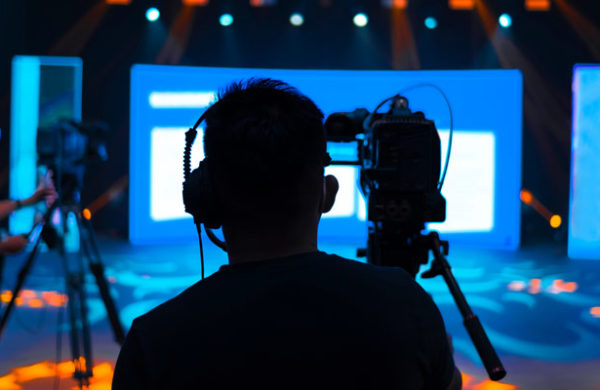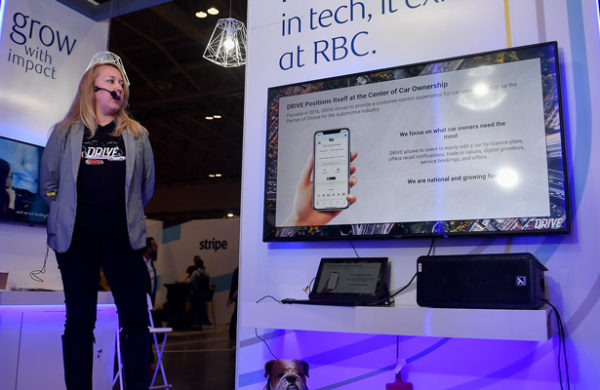
Confused about what projection screen size to rent for your meeting, conference, or other event? You’re not alone. Projection screens come in a huge variety of sizes and shapes, and it can get confusing, fast.
But it’s critical to know how big your screen needs to be because there’s no single standard projector screen size. The last thing you want is a screen that can’t be seen by all your attendees, or worse — one that’s not compatible with the space or projector.
Luckily, once you have your basic event details figured out, calculating your screen size comes down to a few simple factors. To figure out the right projector and screen size for your event, you’ll need to know these basics:
- How many people you’re expecting
- Your content’s aspect ratio (We’ll explain.)
- Your venue’s ceiling height
- How bright your projector needs to be
STEP 1: Determine how many people you’re expecting.
First, confirm how many guests you’re expecting, and how many people can fit into your room. If your event is in a hotel, you can often see how many people will fit in different seating arrangements by looking on the hotel’s website.
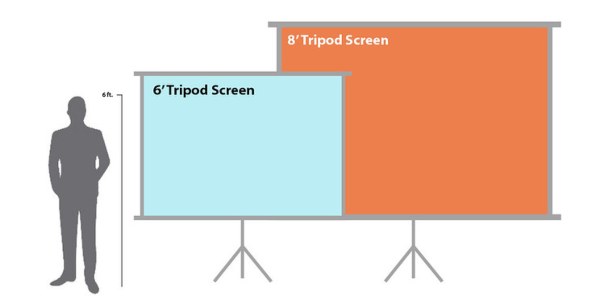
For smaller meetings of up to 100 people, a tripod screen is a great option. Tripod screens come in 6′ and 8′ dimensions, can be either 16:9 and 4:3 aspect ratios, and are flexible in an event space. They also have adjustable legs so ceiling heights aren’t a concern, and they don’t require technician setup.
But if your audience is larger than 100 people, you’ll probably need a fastfold screen in the correct size. These screens require a professional to set-up, and you’ll usually need to confirm all the specific details with your AV provider before renting.
STEP 2: Figure out which aspect ratio your content is in.
The next thing you’ll need to know is if your content is in a 16:9 or 4:3 aspect ratio.
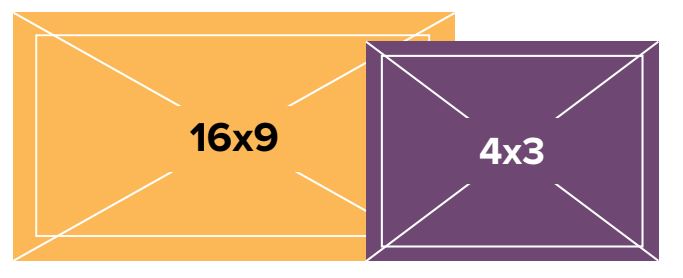
Aspect ratio basically means the shape of the screen, based on a ratio of width to height. For example, a 4:3 aspect ratio for a projection screen means that for every 4 feet of width, there will be 3 feet of height.
These days, almost all content created on a computer is going to be in 16:9. But if you’re really unsure and can’t find the answer from your speaker, go with a 16:9 screen because your AV team can more easily adjust 4:3 content to fit on a 16:9 screen than vice versa.
Quick tip: You can find the aspect ratio of your PPT deck by viewing the “Design” tab and selecting “Page Setup” within your Power Point file. The drop down selected in the “Slides sized for” box will show either 4:3 or 16:9. You can view more information on how to change your slide size here.
Now that you know your audience size and your aspect ratio, you can use this chart as a starting guide.
Projector Screen Size Chart
| Maximum Recommended Audience Size: 16:9 Screen | Recommended Screen Dimensions |
| 100 | 5.5’ tall x 10’ wide |
| 200 | 7’ x 12’ |
| 250 | 8’ x 14’ |
| 300 | 9’ x 16’ |
| 500 | 11.5’ x 24’ |
| Maximum Recommended Audience Size: 4:3 Screen | Recommended Screen Dimensions |
| 100 | 6’ tall x 8’ wide |
| 200 | 7.5’ x 10’ |
| 300 | 9’ x 12’ |
| 500 | 10.5’ x 14’ |
 There are lots of exceptions to this guide, but it’s a solid place to start. For example, if your audience is on the smaller side but you’re in a huge room, you may still want a bigger screen for aesthetic reasons.
There are lots of exceptions to this guide, but it’s a solid place to start. For example, if your audience is on the smaller side but you’re in a huge room, you may still want a bigger screen for aesthetic reasons.
Also, it’s often best to have screens on each side of the stage so that attendees throughout the space can easily see your content. Two screens also provide uniformity to the stage set. There are lots of variables in choosing the right screen size, so be sure to discuss all the details of your event with your AV provider.
For audiences larger than 1,000 people, you might also consider a truss screen or custom setup. These types of screens can be flown or ground supported, and are available in front or rear projection.
STEP 3: Confirm your venue’s ceiling height to make sure you have enough room.
You’re almost there. You’ve chosen your screen size, and now you just have to make sure your venue’s ceilings are tall enough to accommodate the whole set-up.
For 4:3 screens: Add three feet of height for the legs. That means a 7.5’ x 10’ screen will have final dimensions of 10.5′ x 10′.
For 16:9 screens: Add four feet of height for the legs. That means a 5.5′ x 10′ fastfold screen will have final dimensions of 9.5′ x 10′.
This is a good rule of thumb to determine your standard screen height without any kind of dress kit or top valence. Adding a dress kit, which makes screens look a little more polished and professional, will add one more foot of height and four feet of width.
Adding legs and a dress kit means that many larger screens can require ceiling heights of 10′ to 15’+, but the average ceiling height of a meeting room is 8′-10′. That’s why it’s so important to confirm ceiling height.
Most venues have room diagrams or layouts online that clearly state the ceiling height. If you aren’t able to find that information, you can always set up a pre-event site survey for an audio visual technician to ensure the screen will fit into the event layout. If your venue doesn’t have high enough ceilings, consider using multiple smaller screens or additional monitors to make sure every guest can see your content.
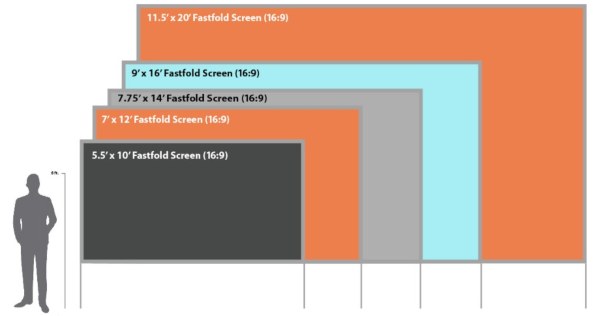
A reference for how big your screen will look once legs are added, which add an additional three to four feet.
Some venues aren’t big enough to have enough space between the screen and projector, also called throw distance. You AV provider can help determine your throw distance and the best placement for your projector and screen.

STEP 4: Confirm your projector and screen are compatible.
If you already have a projector that you plan to use, it’s important to remember that not all projectors and screens work together. As screens increase in size, the lumens (aka the brightness) required in a projector increase as well.
Think of projectors like a flashlight: The light spreads out across the surface the further away that you are. So, the bigger the screen and the farther away you projector is for the screen, the brighter the light needs to me. If your projector doesn’t produce enough lumens, you may have trouble seeing the content on the screen.
Here’s the recommended projector brightness matched with screen sizes:
| Screen Size | Recommended Projector Brightness for Best Results |
| 6’ Tripod Screen | 3,000 |
| 8’ Tripod Screen | 4,000 |
| 5.5’ x 10’ Fastfold | 6,000 |
| 7’ x 12’ Fastfold | 8,000 |
| 8’ x 14’ Fastfold | 10,000 |
| 9’ x 16’ Fastfold | 12,000 |
| 11.5’ x 20’ Fastfold | 15,000 |
| 13.5 x 24’ Fastfold | 30,000 |
These four steps are a great starting point to choosing the right screen and projector. No two events are alike though, and depending on the full scope of your program, there may be many other factors to take into account.
There are many creative solutions to consider, and your AV provider will able to help ensure every guest can see your content in the clearest way possible.
